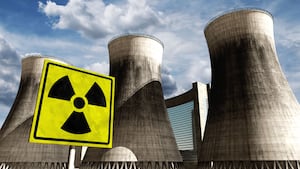The ocean covers more than 70 percent of the planet. And unfortunately it’s acidifying fast thanks to noxious carbon dioxide emissions spewed from industrial smoke stacks, tail pipes from gasoline-guzzling vehicles, and other modern technologies—and then absorbed by seawater. Roughly 22 million tons of carbon dioxide find their way into the ocean every day. The resulting acidification threatens countless marine species that are part of an ecosystem that humans rely on.
Heavily reducing and eventually eliminating the use of fossil fuels will help slow the acidification process. But the issue also raises an intriguing prospect: What if we could use the ocean to combat climate change and possibly even reverse this process? What if the ocean could be used as a trap for carbon dioxide, removing it from the climate change equation indefinitely?
When people talk about capturing carbon from the atmosphere, they are typically referring to what’s called direct air carbon capture, which is meant to suck up carbon dioxide out of the air (or sequester it before it ends up in the air) and storing it away. Storing it often involves pumping it into a geological reservoir where it will hopefully remain indefinitely.
Unfortunately, that’s still an expensive technology, and there’s a chance of carbon dioxide leaking. You also need access to a geological reservoir where you can store the carbon dioxide.
Last December, the National Academy of Sciences released a report that evaluated the feasibility of different proposals that instead focused on the role of the ocean in carbon capture. One of the plans, referred to as ocean alkalinity enhancement, would involve grinding up igneous rocks that are found on shorelines around the world to make the oceans less acidic and more basic (or more alkaline). Theoretically, that would not only address the acidification problem and make the oceans healthier, but also allow these waters to absorb excess carbon dioxide from the atmosphere and prevent it from acting as a greenhouse gas.
“The ocean holds about 50 times as much inorganic carbon as the atmosphere because of its high alkalinity,” Scott Doney, a University of Virginia marine scientist who chaired the National Academy of Sciences panel, told The Daily Beast. “It’s been suggested that if you increase the alkalinity of the ocean… you could potentially increase the capacity of the ocean to remove carbon dioxide from the atmosphere.”
Doney noted that these types of igneous rocks are eroding into the ocean all of the time, so we’re pretty familiar with their ecological effects already. He suggests we could start using an electrochemical process to simply speed up that erosion on the shore to increase the effects. When you increase the alkalinity of seawater, Doney said, chemical reactions cause the carbon dioxide absorbed by the ocean water to transform into other molecules that remain stored in the ocean.
Obviously, you can’t just do this in one area and expect the world’s oceans to become less acidic. Doney emphasized this would have to be a global project.
A bigger obstacle to turning the oceans into a giant sequestration machine for carbon dioxide might be the fact that we’re still not sure what kind of negative impacts to expect on such a grand scale and how long they would last.
“We know that acidifying seawater can have some negative effects on marine life,” Doney said. “Maybe a large discharge of alkalinity could, as well. We just haven’t studied that in much detail.”
Another proposal for using the ocean as a sponge for carbon involves inducing electrolysis (splitting water into hydrogen and oxygen) to remove carbon dioxide from the water and locking it up within mineral salts called carbonates. Gaurav Sant, a professor of civil and environmental engineering at the University of California, Los Angeles is going to test out such a method in a new startup project called SeaChange.
“We do this in two ways,” Sant explained to The Daily Beast. “We do it by taking carbon dioxide that’s contained in seawater and locking it up within mineral carbonates, and we do it by producing mineral hydroxides, which increase the alkalinity, marginally so, of seawater.
“Since the carbon dioxide absorption capacity of seawater is linked to its pH, a small increase in its alkalinity allows you to pull down additional carbon dioxide from the atmosphere,” he said.

Gaurav Sant holding a piece of a new concrete his lab developed to combat climate change.
UCLA Samueli School of EngineeringThe mineral carbonates that contain the sequestered carbon dioxide can be discharged back into the ocean, “where they would remain stable,” Sant said. That means this mineralized carbon dioxide won’t simply be re-released into the seawater. Given how much more carbon the ocean can absorb than the air, Sant believes this technology will be affordable for widespread use if it can be demonstrated and proven safe.
The early adoption of this approach would involve integrating it with desalination plants around the world that take in seawater. Sant and his team are on schedule to pilot the SeaChange technology in Los Angeles and Southeast Asia later this year. He said these demonstrations will be removing between 100 kg and 1,000 kg of carbon dioxide from the ocean per day.
“As we’ve added carbon dioxide to the atmosphere over the last 200 years and the oceans have absorbed that carbon dioxide, the oceans have acidified. At a high level, the ocean's average pH has slipped from a pH of 8.2 to a pH of 8.1,” Sant said. “The SeaChange process does not imply making any drastic changes or interventions in the oceans. What we’re really talking about is marginally increasing the alkalinity of the oceans, at scale, which allows you to increase the carbon dioxide storage capacity of the oceans themselves.”
In other words, this process would bring the oceanic pH back to what it was at the start of the Industrial Revolution about 200 years ago—reversing two centuries of damage wrought by human activity.
That doesn’t mean we should throw out the idea of doing direct air capture completely. It will get cheaper over time, and it could be done while ocean-based methods are also being used. Cleaning up the atmosphere would be an enormous endeavor, so the best strategy puts all hands on deck.
“We’re going to need a portfolio of approaches,” Doney said.
Critics of carbon capture technologies will often say that they’re dangerous because they could be used as an excuse to continue burning fossil fuels. If we’re going to beat climate change, we do need to eliminate the use of fossil fuels as soon as possible, but we also need to do something about the excess carbon dioxide that will still be lingering in the atmosphere for decades to come. Without capturing and sealing off some of that carbon, global warming will still trudge forward and wreak havoc on the planet.
“We are at an inflection point where carbon management is going to be one of the biggest challenges of humanity and society for the next century and beyond,” Sant said.








